With four of us imaging, equipment was always going to be in short
supply, so I just managed to squeeze my modified
EQ3-2 mount and William Optics ZS66
telescope into my weight allowance along with my SBIG ST10 camera and
filter wheel (and laptop!) The mount carried the equipment, albeit
well out of balance in declination when using the ZS66, and guided
satisfactorily using a
#909
clone. Thanks to Olly for the loan of a balance weight - if I'd
brought one I would have been well over the airline limit!
|
The first night (2nd - 3rd August)
saw the equipment set up and tested, and my first main
target was the dark lane of nebulosity B169-71 in Cepheus
(about 3 degrees North West of the better known IC1396)
Early hours of 3rd with the ST10 on the ZS66 at prime focus,
guiding with the AO-8 unit, Luminance 7 x 10 minutes, RGB
each 6 x 3 minutes binned 2x2
Full
Size
|
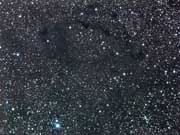
|
|
Following the successful imaging of the
above nebula, M31 was beckoning, so off with the AO-8 and on
with the AP reducer to fit it into the field of view and
reach focus. ST10 with the ZS66 reduced, Luminance 5 x 5
minutes, RGB each 5 x 2 minutes. Quite pleasing considering
the relatively short sub frames. I was quite pleased with
the direct mount guiding too, particularly as when I compare
the image to a Skymap frame the true focal length was around
340 mm!
Full
size
|

|
|
One of the party had brought his Astrotrac with him, and
with it set up on Olly's spare undriven mount on the night
of 3rd - 4th August, I was able to fit my Canon 350D to it
with its 18 mm lens and get some Milky Way shots, all of
which showed up some of the better known targets.
The most southerly part visible appeared through a col
across the valley from the farmhouse. Even though the site
was some 70 miles North of Marseille and Aix, nevertheless
light pollution was very evident. But a pleasing shot
anyway.
Larger
image.
Moving up the sky, the Cygnus region was next on the
list. Larger
image.
Finally the region around Cassiopeia. In all cases, I
used 5 x 5 minute RAW frames, processed in Deep sky Stacker
and Photoshop.
Larger
image.
|
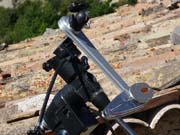
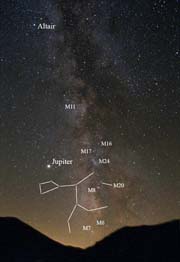
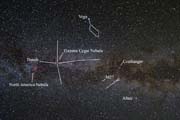
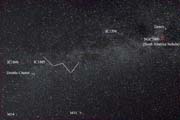
|
|
I returned to my EQ3-2 mount for the following two nights
(4th and 5th) and targeted the area containing M8 and M20 in
Sagittarius with my SBIG camera and 135 mm camera lens at f
5. Luminance 12 x 5 minutes, RGB each 6 x 2 minutes binned
2x2.
Full
Size
Then on to Gamma Cygni, again with the 135 mm lens. This
time I used narrow band filters, with exposures Luminance
(H-alpha) 6 x 10 minutes, O3, S2 each 5 x 4 minutes binned
2x2. Some of the Ha was used as Red in the final composite.
Full
Size
|
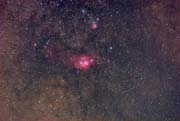
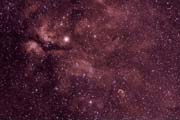
|
|
I imaged two targets with the 135 mm lens on the night of
6th, but realised too late that I had inadvertently moved
the lens stop to f9, so all the frames were too dim to
produce successful images - a wasted night :-(
|
|
|
The night of 7th August was, alas,
cloudy. But we couldn't really complain - we had so far been
very lucky. And the night of 8th again was clear and I moved
on to Olly's 4" Genesis refractor on his EQ6 Pro mount. The
first target was M17 with the ST10, AO-8 and narrowband
filters. Luminance 6 x 10 minutes Ha, GB each 6 x 4 minutes
O3 and S2, Ha again used to provide Red. (See
here for a flight of fancy!)
This image was 'Picture of the
Month' in the November 2008 'Astronomy Now' magazine
Full
size
|

|
|
After M17 I moved over to an
interesting area in Cassiopeia containing several open
clusters in an almost straight line centred on NGC 7788.
Luminance 8 x 2 minutes, RGB each 6 x 2 minutes. This image appeared in the September 2008
issue of Practical Astronomer.
Medium Size
named
Full
size
|
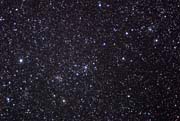
|
Of course there is more to staying at Les Granges than 'just'
astronomy! The house is located in beautiful countryside, quite
remote and very French!
|
This photo shows the farmhouse and positions of the
telescope roll off sheds. the EQ3 position is at the upper
end of the complex, and is of course my own mount - covered
with a large plastic bag hence the white appearance! Olly's
undriven EQ5 type mount (seen above with the Astrotrac) is
behind the outhouse close to the Genesis.
|
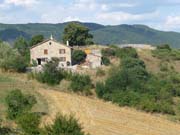
|
|
Here are the two main imaging stations, the Televue
Genesis on the EQ6 mount and the 'Classic' 10" LX200.
And the undriven mount with the Astrotrac and a fine body
of men!
|
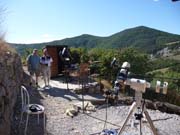
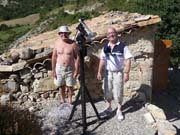
|
|
Olly also has a very good 20" Dobsonian, affectionately
known as 'Sir Isaac'. But in a major oversight I never got a
photograph of it, although I had some excellent views
through it.
Here is the upper station, reserved for visitor's
equipment, with my little EQ3-2 mount, and Sir Isaac's shed
just below.
And the view looking South. Although the hills appear
intrusive, in practice they were not a problem and fine
views of the Scorpius and Sagittarius areas of the Milky Way
were available.
|
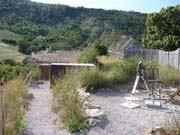
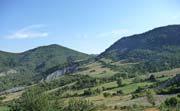
|
|
The fence to the North of the viewing stations, in
particular the visitor's area, is there partly for shelter
from any wind, but also to mask off any glare from a few
lights in the village of Etoile St Cyrice just a few hundred
metres from the farmhouse. No light pollution as far as the
sky is concerned, but enough to spoil well adapted night
vision.
An attractive little village, dominated by quite a large
church, (just out of view to the left of the main picture)
|
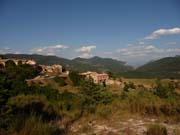
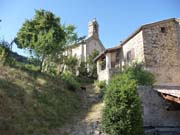
|
|
I couldn't resist this while out taking pics of the area.
This is a Swallowtail butterfly, scarce in the UK, but there
were plenty around Les Granges!
|

|
|
Etoile St. Cyrice is situated a few miles to the West of
the mediaeval town of Orpierre, which is dominated by high
rocky (limestone?) outcrops, and very popular with tourists,
particularly climbers and walkers. So the town has large car
parking areas for both cars and buses.
|
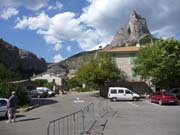
|
|
This magnificent pinnacle is the most obvious landmark,
but the other side of the valley running into the hills was
the main magnet for climbers
|
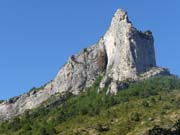
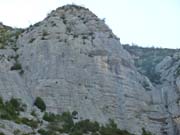
|
|
The town also boasts a substantial camp/caravan site and
a large outdoor swimming pool. We visited it, but didn't
swim there - costume rules were particularly specific and we
didn't have the correct form! But several miles away there
is a beautifully situated large reservoir open for
watersports and well visited by boaters and swimmers alike.
Quite warm enough in August, though probably rather cold in
the earlier and later seasons!
|


|
|
Numerous interesting buildings and back lanes in the
town, many of them hundreds of years old.
|
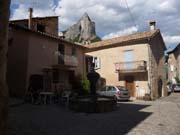
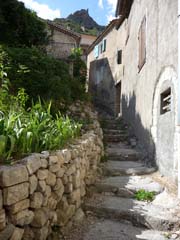
|
|
The hilly country in this area is stunning! Although most
of the lower hills are tree covered, they rise to over 1000
metres, with the French Maritime Alps in the distance. This
photograph was taken from a pass, the Col de St Jean, 1158
metres high, looking towards the Alps from the South West.
The outcrop above Orpierre can just be seen at the very
right of the picture.
But when not out sightseeing, while conserving energies
for a night's astronomy, holidaying at Les Granges is very
relaxing!
|
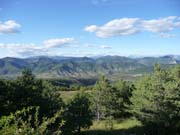
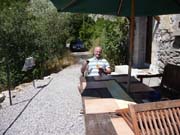
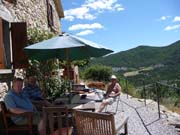
|
|
Although Les Granges is offered as self catering, there
was always the option of evening meals provided by the
establishment! Sometimes in the house, on this occasion a
delicious barbeque outside.
Thanks to Olly and Monique for their hospitality (and
Provençal cuisine). We'll be back!
|
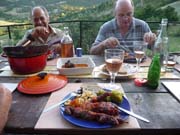
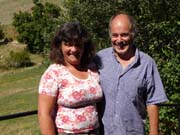
|
|
Postscript.
Olly is always looking to improve his equipment.
But no, Olly, you can't have my ST10!
|
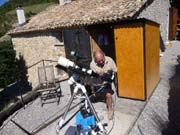
|






























